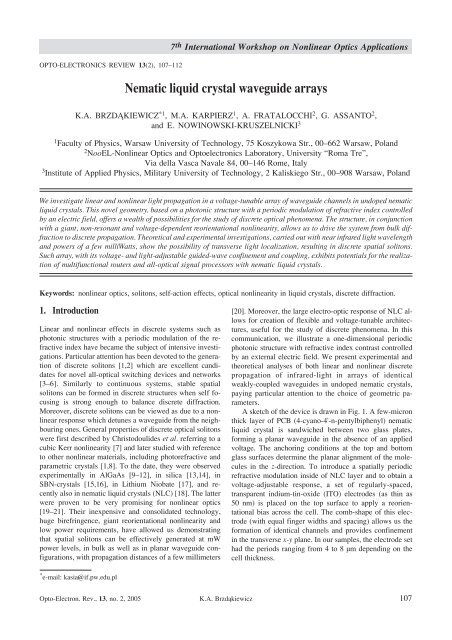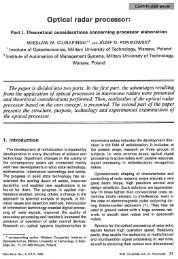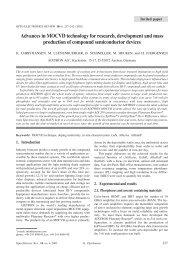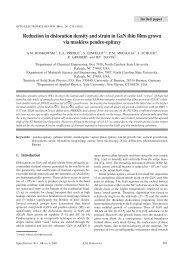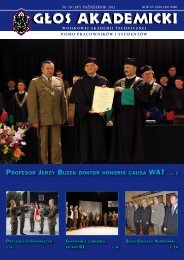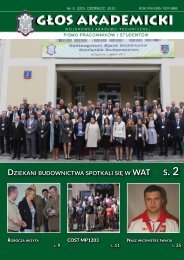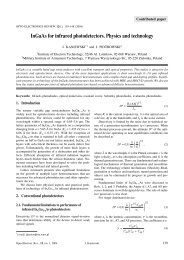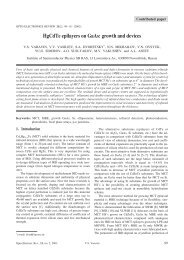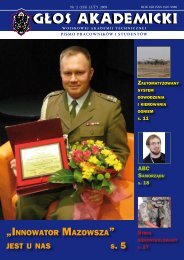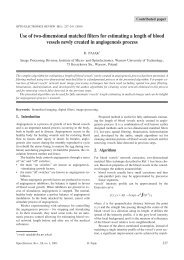Nematic liquid crystal waveguide arrays
Nematic liquid crystal waveguide arrays
Nematic liquid crystal waveguide arrays
Create successful ePaper yourself
Turn your PDF publications into a flip-book with our unique Google optimized e-Paper software.
OPTO-ELECTRONICS REVIEW 13(2), 107–112<br />
7 th International Workshop on Nonlinear Optics Applications<br />
<strong>Nematic</strong> <strong>liquid</strong> <strong>crystal</strong> <strong>waveguide</strong> <strong>arrays</strong><br />
K.A. BRZD¥KIEWICZ *1 , M.A. KARPIERZ 1 , A. FRATALOCCHI 2 , G. ASSANTO 2 ,<br />
and E. NOWINOWSKI-KRUSZELNICKI 3<br />
1 Faculty of Physics, Warsaw University of Technology, 75 Koszykowa Str., 00–662 Warsaw, Poland<br />
2 NooEL-Nonlinear Optics and Optoelectronics Laboratory, University “Roma Tre”,<br />
Via della Vasca Navale 84, 00–146 Rome, Italy<br />
3 Institute of Applied Physics, Military University of Technology, 2 Kaliskiego Str., 00–908 Warsaw, Poland<br />
We investigate linear and nonlinear light propagation in a voltage-tunable array of <strong>waveguide</strong> channels in undoped nematic<br />
<strong>liquid</strong> <strong>crystal</strong>s. This novel geometry, based on a photonic structure with a periodic modulation of refractive index controlled<br />
by an electric field, offers a wealth of possibilities for the study of discrete optical phenomena. The structure, in conjunction<br />
with a giant, non-resonant and voltage-dependent reorientational nonlinearity, allows us to drive the system from bulk diffraction<br />
to discrete propagation. Theoretical and experimental investigations, carried out with near infrared light wavelength<br />
and powers of a few milliWatts, show the possibility of transverse light localization, resulting in discrete spatial solitons.<br />
Such array, with its voltage- and light-adjustable guided-wave confinement and coupling, exhibits potentials for the realization<br />
of multifunctional routers and all-optical signal processors with nematic <strong>liquid</strong> <strong>crystal</strong>s.<br />
Keywords: nonlinear optics, solitons, self-action effects, optical nonlinearity in <strong>liquid</strong> <strong>crystal</strong>s, discrete diffraction.<br />
1. Introduction<br />
Linear and nonlinear effects in discrete systems such as<br />
photonic structures with a periodic modulation of the refractive<br />
index have became the subject of intensive investigations.<br />
Particular attention has been devoted to the generation<br />
of discrete solitons [1,2] which are excellent candidates<br />
for novel all-optical switching devices and networks<br />
[3–6]. Similarly to continuous systems, stable spatial<br />
solitons can be formed in discrete structures when self focusing<br />
is strong enough to balance discrete diffraction.<br />
Moreover, discrete solitons can be viewed as due to a nonlinear<br />
response which detunes a <strong>waveguide</strong> from the neighbouring<br />
ones. General properties of discrete optical solitons<br />
were first described by Christodoulides et al. referring to a<br />
cubic Kerr nonlinearity [7] and later studied with reference<br />
to other nonlinear materials, including photorefractive and<br />
parametric <strong>crystal</strong>s [1,8]. To the date, they were observed<br />
experimentally in AlGaAs [9–12], in silica [13,14], in<br />
SBN-<strong>crystal</strong>s [15,16], in Lithium Niobate [17], and recently<br />
also in nematic <strong>liquid</strong> <strong>crystal</strong>s (NLC) [18]. The latter<br />
were proven to be very promising for nonlinear optics<br />
[19–21]. Their inexpensive and consolidated technology,<br />
huge birefringence, giant reorientational nonlinearity and<br />
low power requirements, have allowed us demonstrating<br />
that spatial solitons can be effectively generated at mW<br />
power levels, in bulk as well as in planar <strong>waveguide</strong> configurations,<br />
with propagation distances of a few millimeters<br />
[20]. Moreover, the large electro-optic response of NLC allows<br />
for creation of flexible and voltage-tunable architectures,<br />
useful for the study of discrete phenomena. In this<br />
communication, we illustrate a one-dimensional periodic<br />
photonic structure with refractive index contrast controlled<br />
by an external electric field. We present experimental and<br />
theoretical analyses of both linear and nonlinear discrete<br />
propagation of infrared-light in <strong>arrays</strong> of identical<br />
weakly-coupled <strong>waveguide</strong>s in undoped nematic <strong>crystal</strong>s,<br />
paying particular attention to the choice of geometric parameters.<br />
A sketch of the device is drawn in Fig. 1. A few-micron<br />
thick layer of PCB (4-cyano-4'-n-pentylbiphenyl) nematic<br />
<strong>liquid</strong> <strong>crystal</strong> is sandwiched between two glass plates,<br />
forming a planar <strong>waveguide</strong> in the absence of an applied<br />
voltage. The anchoring conditions at the top and bottom<br />
glass surfaces determine the planar alignment of the molecules<br />
in the z-direction. To introduce a spatially periodic<br />
refractive modulation inside of NLC layer and to obtain a<br />
voltage-adjustable response, a set of regularly-spaced,<br />
transparent indium-tin-oxide (ITO) electrodes (as thin as<br />
50 nm) is placed on the top surface to apply a reorientational<br />
bias across the cell. The comb-shape of this electrode<br />
(with equal finger widths and spacing) allows us the<br />
formation of identical channels and provides confinement<br />
in the transverse x-y plane. In our samples, the electrode set<br />
had the periods ranging from 4 to 8 µm depending on the<br />
cell thickness.<br />
* e-mail: kasia@if.pw.edu.pl<br />
Opto-Electron. Rev., 13, no. 2, 2005 K.A. Brzd¹kiewicz 107
<strong>Nematic</strong> <strong>liquid</strong> <strong>crystal</strong> <strong>waveguide</strong> <strong>arrays</strong><br />
Fig. 1. Sketch of the <strong>liquid</strong> <strong>crystal</strong> <strong>waveguide</strong> array. The period of<br />
the electrode distribution L varies from 4 to 8 µm and the cell<br />
thickness d from 3 to 7 µm (depending on the cell).<br />
2. Numerical results<br />
The application of an appropriate voltage causes the reorientation<br />
of the NLC molecules which, as a result of free-<br />
-energy minimization, tend to align parallel to the direction<br />
of the electric field. The angular molecular distribution can<br />
be theoretically calculated from the Euler-Lagrange equation<br />
describing reorientation through an applied bias [21].<br />
The numerical results shown in this communication were<br />
obtained for the <strong>liquid</strong> <strong>crystal</strong> PCB, with low-frequency<br />
anisotropy De if = 115 . . Owing to a new arrangement of the<br />
orientation angle, a periodic spatial modulation of the refractive<br />
index occurs. Figure 2 shows an example of refractive<br />
index distribution (for x-polarized light) obtained in<br />
the 5-µm-thick sample and for electrode period of 6 µm.<br />
Figure 2(b) presents numerical results of refractive index<br />
distribution in the middle of the NLC layer (i.e., for x =0)<br />
and three different values of bias. As one can see, the refractive<br />
index increases mainly in the regions under the<br />
electrodes and thereby the channel <strong>waveguide</strong>s are well defined<br />
through lateral confinement. In general, the higher refractive<br />
index is obtained for a higher bias, and better light<br />
guiding is expected. In this case, the coupling length, defined<br />
as the propagation distance at which whole energy<br />
goes from one <strong>waveguide</strong> to the neighbouring ones [23],<br />
gets longer.<br />
Numerical simulations of light propagating in the NLC<br />
layer were carried out with BPM injecting a TM-polarized<br />
Gaussian beam. Additionally, in each propagation step the<br />
molecular orientation distribution was recalculated based<br />
on minimization of the total free-energy of the <strong>liquid</strong> <strong>crystal</strong><br />
under the influence of both the low-frequency (bias) and<br />
the optical electric field [21]. The refractive indices characteristic<br />
of PCB are n 0 = 1.52 and n e = 1.69 at a wavelength<br />
of 1064 nm. Figure 3 displays light propagation in the linear<br />
(low input optical power) regime. In this case, the electric<br />
bias plays a crucial role in the reorientation process,<br />
leading to the periodic modulation of a refractive index, as<br />
shown in Fig. 2. While standard diffraction (in the homogenous<br />
medium) takes place in the transverse y-z plane in the<br />
absence of bias, discrete diffraction [1,2,22] sets-in and can<br />
be tuned in strength as the voltage increases and the array<br />
is formed. As a consequence of discrete diffraction, energy<br />
redistributes among the guiding channels, as clearly visible<br />
in Figs. 3(b)–3(e) showing the cross-sections in x = 0 and<br />
beam transverse profiles in the x-y plane along propagation.<br />
In the analysed geometry, the optimisation of such parameters<br />
as the optical properties (especially birefringence)<br />
of NLC, the NLC layer thickness, the electrode spacing and<br />
width, allows us to obtain properly coupled and well defined<br />
<strong>waveguide</strong>s. Moreover, the magnitude of discrete diffraction<br />
can be easily tuned by controlling the voltage.<br />
Figure 4 shows how the coupling between channels and<br />
the resulting discrete diffraction changes with the applied<br />
voltage. An increase in bias reduces angular divergence of<br />
the beam; light is more confined within the core region of<br />
the channels, and the coupling length increases. As intuitive,<br />
by increasing the bias it is possible to progressively<br />
Fig. 2. Spatial distribution of the refractive index for light linearly polarized along x, NLC layer 5-µm thick and electrode width and spacing<br />
of 3 µm. Three-dimensional map for the bias V = 1.35 V (a), refractive index in the middle of the NLC cell (i.e., for x = 0) for three different<br />
applied voltages (b).<br />
108 Opto-Electron. Rev., 13, no. 2, 2005 © 2005 COSiW SEP, Warsaw
7 th International Workshop on Nonlinear Optics Applications<br />
Fig. 3. Numerical results for a low-power Gaussian optical input of waist 2 µm and wavelength 1064 nm, for a 5-µm-thick NLC-cell,<br />
electrode period of 6 µm and applied voltage V = 1.35 V. Discrete diffraction for the beam launched into one input <strong>waveguide</strong> (a). Beam<br />
transverse profiles (for x = 0) (b) and (c), spatial distribution of light intensity (d) and (e) after 1- and 2-mm propagation distances,<br />
respectively.<br />
reduce light transfer between channels. By using a proper<br />
bias the difference between refractive indices in each channel<br />
and in the gaps between the finger electrodes can be<br />
maximized. However, the saturating character of this reorientation<br />
process causes an excessive voltage to flatten the<br />
index profile and thereby weaken the spatial definition of<br />
each channel. The non local response of NLC, in fact, is<br />
such that an electric field increases the index not only under<br />
electrodes but also between them. For high enough applied<br />
voltages, the NLC elastic response mediates reorientation<br />
in the regions between neighbouring <strong>waveguide</strong>s,<br />
thereby reducing the refractive index modulation. This is<br />
also visible in Fig. 5(a) where, for a fixed cell thickness,<br />
the coupling length first increases with applied voltage until<br />
saturation and non locality makes it decrease again.<br />
Figure 5 shows how discrete diffraction can be modified<br />
by varying the sample geometry. By reducing the<br />
thickness of the NLC layer it is possible to obtain better defined<br />
<strong>waveguide</strong>s, i.e., an increased coupling length,<br />
Fig. 5(b). Figure 5(c) shows how the light beam injected in<br />
a 2.5-µm-thick sample for low bias (1.2 V) is confined<br />
within 3 channels after 1-mm propagation. Conversely, for<br />
thicker NLC layers, the change in coupling length versus<br />
voltage is negligible and discrete diffraction is hardly affected.<br />
As expected, the coupling length can be also reduced by<br />
decreasing the electrode periodicity. However, a close<br />
proximity of the stripe electrodes reduces the coupling<br />
length dependence with bias. For example, in a 5-µm-thick<br />
sample with 4-µm electrode period, by varying the voltage<br />
from 1.1 to 1.9 V, the change in coupling distance is<br />
around 60 µm. The analyses demonstrate that, in the process<br />
of sample designing, it is important to find the optimum<br />
ratio between electrode width and sample thickness<br />
in order to obtain a well tunable structure for suitable values<br />
of the applied voltage.<br />
Fig. 4. Linear coupling between channels and its dependence on applied voltage for NLC thickness of 5 µm and electrode period of 6 µm.<br />
The optical intensity distribution is colour-inverted (i.e., darker corresponds to a higher intensity) and evaluated after 1 mm propagation.<br />
Opto-Electron. Rev., 13, no. 2, 2005 K.A. Brzd¹kiewicz 109
<strong>Nematic</strong> <strong>liquid</strong> <strong>crystal</strong> <strong>waveguide</strong> <strong>arrays</strong><br />
Fig. 5. Linear coupling between channels versus NLC thickness. Dependence of a coupling length on applied voltage for three cell<br />
thicknesses d (a). Coupling length versus NLC thickness at a voltage V = 1.2 V (b). Spatial intensity distribution calculated after 1 mm<br />
propagation and V = 1.2 V for different values of NLC thickness d (c).<br />
Going from the linear to the nonlinear regime, as the<br />
power of the propagating beam increases, the refractive index<br />
of the excited <strong>waveguide</strong>s is modified by the nonlinearity,<br />
and discrete diffraction can be effectively counteracted<br />
by the power-induced detuning of the launch channel.<br />
As shown in Fig. 6, as the light power gets higher, the<br />
beam narrows in space. Finally, when the input beam is intense<br />
enough, nonlinearity completely balances diffraction<br />
and light propagates (transversely) localized in a limited region<br />
of the array or, for high enough excitations, in a single<br />
channel. Such a beam, which propagates maintaining an invariant<br />
transverse profile, is called discrete spatial soliton<br />
[1,2,18,22]. It is possible to consider either partially localized<br />
or “wide” solitons with energy in a few channels, or<br />
totally localized “narrow” solitons, with energy essentially<br />
confined in the input <strong>waveguide</strong>. It is worth to underline<br />
that, due to light confinement, discrete systems require less<br />
power for solitons than comparable slab <strong>waveguide</strong> or bulk<br />
media.<br />
Fig. 6. Beam distribution versus input beam power calculated for V<br />
= 1.35 V after 1-mm propagation. Discrete diffraction is limited<br />
and discrete spatial solitons are generated due to increase in input<br />
light power.<br />
3. Experimental results<br />
We performed experiments in NLC cell of a thickness of<br />
5–6 µm and with an array period of 6 µm. The beam from a<br />
Nd:YAG laser (l = 1064 nm) was focused to a diameter of<br />
approximately 4 µm at the entrance of the sample. The<br />
beam evolution in the NLC cell was observed through a<br />
CCD camera detecting the photons scattered above the cell.<br />
Photographs were taken at various biases, as shown in<br />
Fig. 7. The pictures show the change in discrete beam propagation<br />
for a fixed input power of 5 mW and a propagation<br />
distance of 1 mm. As one can see, by increasing the applied<br />
voltage the coupling length becomes longer and beam spatial<br />
localization is enhanced. For low voltages [Figs. 7(a)<br />
and 7(b)], the beam is guided in a few channels, whereas<br />
V = 1.45 V it essentially propagates in just one of them.<br />
As predicted theoretically, however, spatial light localization<br />
can be also obtained by increasing the beam power,<br />
leading to discrete soliton generation.<br />
Figure 8 shows the experimental photographs of light<br />
propagation depending on optical power in the structure.<br />
When no voltage is applied, the beam diffracts in the y-z<br />
plane, progressively reducing its intensity and becoming<br />
hardly visible after a few Rayleigh ranges, see Fig. 8(a).<br />
Figure 8(b) shows discrete diffraction of the excitation injected<br />
into a single channel for a bias V = 1.1 V, large<br />
enough to create an array of well-defined channels. In<br />
z = 1.4 mm, the input has spread over 13 adjacent <strong>waveguide</strong>s.<br />
Compared to standard diffraction in a homogeneous<br />
1D geometry [planar <strong>waveguide</strong>, Fig. 8(a)], discrete<br />
diffraction [Fig. 8(b)] gives rise to the smaller divergence.<br />
Figures 8(c)–8(e) present the successive changes of the<br />
110 Opto-Electron. Rev., 13, no. 2, 2005 © 2005 COSiW SEP, Warsaw
7 th International Workshop on Nonlinear Optics Applications<br />
4. Conclusions<br />
Fig. 7. Experimental results showing a 5-mW Nd:YAG beam after<br />
1-mm propagation for three different applied voltages.<br />
character of discrete propagation obtained due to increment<br />
of the beam evolution versus optical power. As expected,<br />
a high excitation mismatches the input <strong>waveguide</strong>, resulting<br />
in a “narrow” discrete soliton [Fig. 8(e)]. Figures<br />
8(f)–8(i) show the corresponding beam transverse profiles<br />
in z = 1.4 mm.<br />
In conclusions, we have presented nonlinear <strong>waveguide</strong><br />
<strong>arrays</strong> in undoped nematics. The investigated geometry<br />
takes advantage of both the electro-optic and all-optical<br />
response of <strong>liquid</strong> <strong>crystal</strong>s in a planar arrangement, offering<br />
considerable flexibility both in the linear and nonlinear<br />
regimes by voltage tuning the relevant parameters.<br />
The giant nonlinear response characteristic of molecular<br />
reorientation in such medium, allows for observation of<br />
discrete spatial solitons at mW levels, paving the way to<br />
multifunctional routers and signal processors in <strong>liquid</strong><br />
<strong>crystal</strong>s. The theoretical predictions are in excellent<br />
agreement with the experimental results, and further<br />
work is underway to enlighten a variety of additional fascinating<br />
phenomena including gap solitons and discrete<br />
breathers.<br />
Acknowledgments<br />
This work was partially supported by the State Committee<br />
for Scientific Research under grant No. 4 T11B 058 25.<br />
Fig. 8. Linear propagation (standard diffraction) of the beam in the homogenous planar <strong>waveguide</strong> (i.e., at zero voltage) (a). Light<br />
propagation (for voltage of 1.1 V) for different input powers of the beam launched into one channel (b–e). Acquired transverse profiles<br />
(solid line) in z = 1.4 mm, corresponding to the cases (b–e) (f–i). The dashed-line graphs are calculated profiles matching the experimental<br />
conditions.<br />
Opto-Electron. Rev., 13, no. 2, 2005 K.A. Brzd¹kiewicz 111
<strong>Nematic</strong> <strong>liquid</strong> <strong>crystal</strong> <strong>waveguide</strong> <strong>arrays</strong><br />
References<br />
1. F. Lederer, S. Darmanyan, and A. Kobyakov, “Discrete<br />
solitons”, in Spatial Solitons, edited by S. Trillo and<br />
W. Torruellas, Wiley, New York, 2002.<br />
2. A.A. Sukhorukov, Y.S. Kivshar, H.S. Eisenberg, and Y.<br />
Silberberg, “Spatial optical solitons in <strong>waveguide</strong> <strong>arrays</strong>”,<br />
IEEE J. Quantum Electron. 39, 31 (2003).<br />
3. D.N. Christodulides and E.D. Eugenieva, “Blocking and<br />
routing discrete solitons in two-dimensional networks of<br />
nonlinear <strong>waveguide</strong> <strong>arrays</strong>”, Phys. Rev. Lett. 87, 233901<br />
(2001); E.D. Eugenieva, N.K. Efremidis, and D.N. Christodoulides,<br />
“Minimizing bending losses in two-dimensional<br />
discrete soliton networks”, Opt. Lett. 26, 1876 (2001), “Design<br />
of switching junctions for two-dimensional discrete<br />
soliton networks”, Opt. Lett. 26, 1978 (2001), “Minimizing<br />
bending losses in two-dimensional discrete soliton networks:<br />
errata”, Opt. Lett. 27, 369 (2002).<br />
4. R. Morandotti, U. Peschel, J.S. Aitchison, H.S. Eisenberg,<br />
and Y. Silberberg, “Dynamics of discrete solitons in optical<br />
<strong>waveguide</strong> <strong>arrays</strong>”, Phys. Rev. Lett. 81, 2726 (1999).<br />
5. W. Królikowski and Y.S. Kivshar, “Soliton-based optical<br />
switching in <strong>waveguide</strong> <strong>arrays</strong>”, J. Opt. Soc. Am. B13, 876<br />
(1996).<br />
6. O. Bang and P. Miller, ”Exploiting discreteness for switching<br />
in <strong>waveguide</strong> <strong>arrays</strong>”, Opt. Lett. 21, 1105 (1996).<br />
7. D.N. Christodoulides and R.I. Joseph, “Discrete self-focusing<br />
in nonlinear <strong>arrays</strong> of coupled <strong>waveguide</strong>s”, Opt. Lett.<br />
13, 794 (1988).<br />
8. C. Etrich, F. Lederer, B. Malomed, T. Peschel, and U.<br />
Peschel, “Optical solitons in media with a quadratic<br />
nonlinearity”, in Progress in Optics, Vol. 41, pp. 483, edited<br />
by E. Wolf, Elsevier Science Publishers 2000; T. Peschel,<br />
U. Peschel, and F. Lederer, “Discrete bright solitary waves<br />
in quadratically nonlinear media”, Phys. Rev. E57, 1127<br />
(1998).<br />
9. J. Meier, G.I. Stegeman, Y. Silberberg, R. Morandotti, and<br />
J.S. Aitchison, “Nonlinear optical beam interactions in<br />
<strong>waveguide</strong> <strong>arrays</strong>”, Phys. Rev. Lett. 93, 093903 (2004).<br />
10. R. Morandotti, H.S. Eisenberg, Y. Silberberg, M. Soler, and<br />
J.S. Aitchison, “Self-focusing and defocusing in <strong>waveguide</strong><br />
<strong>arrays</strong>”, Phys. Rev. Lett. 86, 3296 (2001).<br />
11. H.S. Eisenberg, Y. Silberberg, R. Morandotti, A.R. Boyd,<br />
and J.S. Aitchison, “Discrete spatial optical solitons in<br />
<strong>waveguide</strong> <strong>arrays</strong>”, Phys. Rev. Lett. 81, 3383 (1998); “Diffraction<br />
management”, Phys. Rev. Lett. 85, 1863 (2000).<br />
12. P. Millar, J.S. Aitchison, J.U. Kang, G.I. Stegeman, A.<br />
Villeneuve, G.T. Kennedy, and W. Sibbett, J. Opt. Soc. Am.<br />
B14, 3224 (1997).<br />
13. D. Cheskis, S. Bar-Ad, R. Morandotti, J.S. Aitchison, H.S.<br />
Eisenberg, Y. Silberberg, and D. Ross, “Strong spatiotemporal<br />
localization in a silica nonlinear <strong>waveguide</strong> array”,<br />
Phys. Rev. Lett. 91, 223901 (2003).<br />
14. T. Pertsch, U. Peschel, F. Lederer, J. Burghoff, M. Will, S.<br />
Nolte, and A. Tunnermann, “Discrete diffraction in two-dimensional<br />
<strong>arrays</strong> of coupled <strong>waveguide</strong>s in silica”, Opt.<br />
Lett. 29, 468 (2004).<br />
15. N.K. Efremidis, S. Sears, D.N. Christodoulides, J.W.<br />
Fleischer, and M. Segev, “Discrete solitons in photorefractive<br />
optically induced photonic lattices”, Phys. Rev. E66,<br />
046602 (2002).<br />
16. J.W. Fleisher, T. Carmon, M. Segev, N.K. Efremidis, and<br />
D.N. Christodoulides, “Observation of discrete solitons in<br />
optically induced real time <strong>waveguide</strong> <strong>arrays</strong>”, Phys. Rev.<br />
Lett. 90, 023902 (2003); J.W. Fleisher, M. Segev, N.K.<br />
Efremidis, and D.N. Christodoulides, “Observation of<br />
two-dimensional discrete solitons in optically induced nonlinear<br />
photonic lattices”, Nature 422, 147 (2003).<br />
17. R. Iwanow, R. Schiek, G.I. Stegeman, T. Pertsch, F.<br />
Lederer, Y. Min, and W. Sohler, “Observation of discrete<br />
quadratic solitons”, Phys. Rev. Lett. 93, 113902 (2004).<br />
18. A. Fratalocchi, G. Assanto, K.A. Brzd¹kiewicz, and M.A.<br />
Karpierz, “Discrete propagation and spatial solitons in nematic<br />
<strong>liquid</strong> <strong>crystal</strong>s”, Opt. Lett. 29, 1530 (2004).<br />
19. I.C. Khoo and S.T. Wu, Optics and Nonlinear Optics of Liquid<br />
Crystals, World Scientific Publ., Singapore 1997; F.<br />
Simoni, Nonlinear Optical Properties of Liquid Crystals,<br />
World Scientific Publ., London, 1997.<br />
20. M. Peccianti, G. Assanto, A. De Luca, C. Umeton, and I.C.<br />
Khoo, “Electrically assisted self-confinement and waveguiding<br />
in planar nematic <strong>liquid</strong> <strong>crystal</strong> cells”, Appl. Phys.<br />
Lett. 77, 7 (2000); M. Peccianti, K.A. Brzd¹kiewicz, and G.<br />
Assanto, “Nonlocal spatial soliton interactions in nematic<br />
<strong>liquid</strong> <strong>crystal</strong>s”, Opt. Lett. 27, 1460 (2002); G. Assanto and<br />
M. Peccianti, “Spatial solitons in nematic <strong>liquid</strong> <strong>crystal</strong>s”,<br />
IEEE J. Quantum Electron. 39, 13 (2003); M.A. Karpierz,<br />
“Solitary waves in <strong>liquid</strong> <strong>crystal</strong>line <strong>waveguide</strong>s”, Phys.<br />
Rev. E66, 036603 (2002); M.A. Karpierz, M. Sierakowski,<br />
M. Œwi³³o, and T.R. Woliñski, “Self focusing in <strong>liquid</strong> <strong>crystal</strong>line<br />
<strong>waveguide</strong>s”, Mol. Cryst. Liq. Cryst. 320, 157<br />
(1998).<br />
21. N.V. Tabiryan, A.V. Sukhov, and B.Ya. Zel'dovich,<br />
“Orientational optical nonlinearity of <strong>liquid</strong> <strong>crystal</strong>s”, Mol.<br />
Cryst. Liq. Cryst. 136, 1 (1986); P.J. Collings, M. Hird, Introductions<br />
to Liquid Crystals – Chemistry and Physics,<br />
Taylor & Francis, London 1997.<br />
22. F. Lederer and Y. Silberberg, “Discrete solitons”, Opt. Photon.<br />
News 2, 49 (2002); D.N. Christodoulides, F. Lederer,<br />
and Y. Silberberg, “Discretising light behaviour in linear<br />
and nonlinear <strong>waveguide</strong> lattices”, Nature 424, 817 (2003).<br />
23. A. Yariv, Optical Electronics in Modern Communications.<br />
Oxford Press, New York 1997.<br />
112 Opto-Electron. Rev., 13, no. 2, 2005 © 2005 COSiW SEP, Warsaw


